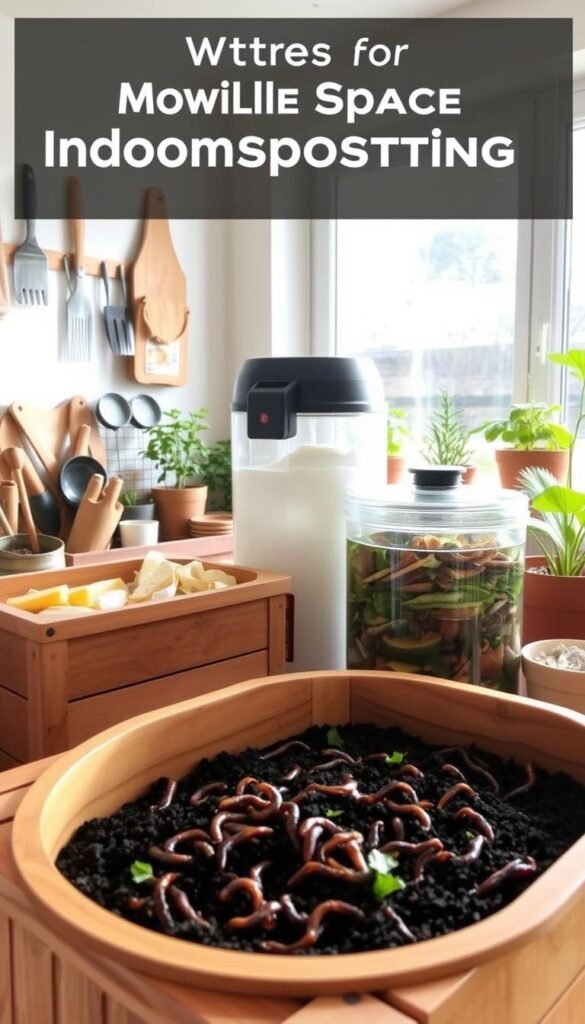What if your food scraps could become a powerhouse for your plants? Even without a backyard, you can transform leftovers into rich soil boosters. Indoor methods like vermicomposting and bokashi fermentation make it easy to recycle kitchen waste year-round—no matter the weather.
Vermicomposting uses red wiggler worms to break down organic matter quickly. It’s odor-free and fits neatly under a sink. Bokashi, on the other hand, relies on beneficial microbes to ferment waste. Both systems work in tight spaces and keep your trash can lighter.
This guide walks you through setting up each system, from choosing bins to troubleshooting hiccups. You’ll learn how to turn banana peels and coffee grounds into “black gold” for houseplants or patio gardens. Plus, discover clever hacks to avoid common mistakes.
Ready to slash waste and grow healthier greens? Let’s dive into these eco-friendly solutions that turn everyday scraps into gardening wins.
Introduction to Small Space Composting
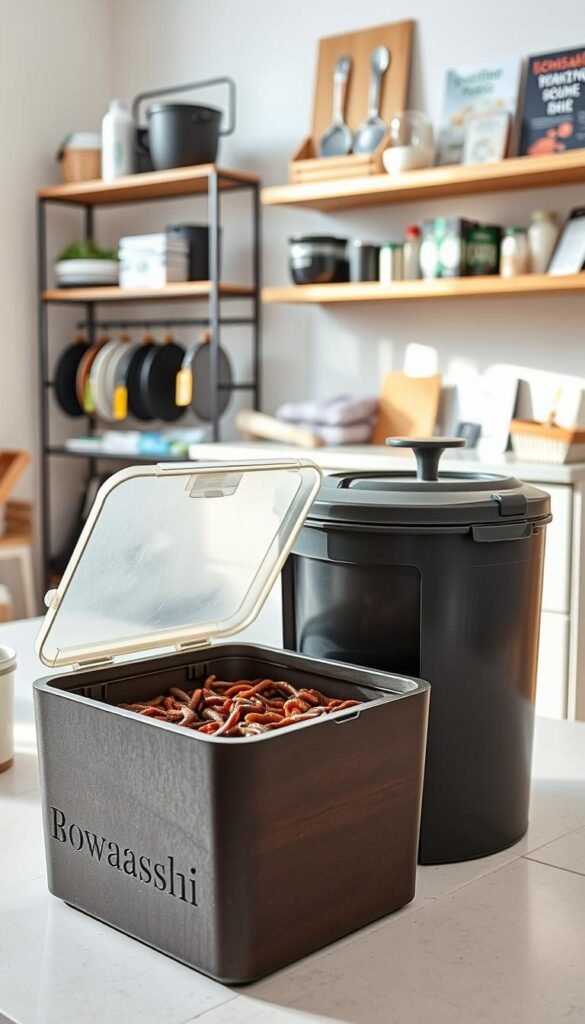
Transforming food scraps into compost is possible, even in tight quarters. Indoor systems let you recycle kitchen leftovers year-round without needing a yard. Instead of tossing banana peels or coffee grounds, you’ll turn them into nutrient-rich soil enhancers—right from your countertop.
This process breaks down organic material using natural methods. Unlike outdoor piles, indoor setups work faster and stay odor-free when managed properly. You’ll divert waste from landfills while creating “black gold” for houseplants or balcony gardens.
Two popular systems stand out for urban homes:
| Method | Best For | Equipment Needed | Timeframe |
|---|---|---|---|
| Worm Bins | Fruit/veggie scraps | Ventilated container, bedding | 2-3 months |
| Bokashi | All food types | Airtight bucket, bran mix | 4-6 weeks |
Worm bins rely on red wigglers to munch through scraps, while bokashi uses fermentation. Both fit under sinks or in closets but handle different materials. Later sections will guide you through setup details and maintenance tricks.
By adopting these methods, you’ll shrink your trash output and boost plant health. Ready to turn yesterday’s leftovers into tomorrow’s garden magic? Let’s explore how each system works.
Understanding Vermicomposting and Worm Bins
Red wiggler worms are tiny but mighty allies in turning kitchen leftovers into plant-ready nutrients. These efficient eaters process organic matter through a natural digestion cycle, leaving behind nutrient-packed castings. The system thrives in stacked containers where worms migrate upward as they finish breaking down layers of material.
How Worm Bins Work
A typical setup uses 3-tiered bins with ventilation holes. Start with bedding like shredded newspaper or coconut coir in the bottom tray. Add worms and small amounts of chopped scraps. As they consume each layer, they’ll move upward, leaving finished compost below.
Maintain moisture like a damp sponge—too dry slows digestion, while excess water causes odor. Stir the contents weekly to aerate and prevent clumping. Harvest the lowest tray every 2-3 months when castings resemble dark, crumbly soil.
Ideal Food Scraps for Worm Composting
Stick to plant-based materials that break down easily:
- Fruit peels (bananas, apples)
- Vegetable trimmings (carrot tops, lettuce)
- Used coffee grounds and tea leaves
- Crushed eggshells for pH balance
Avoid citrus, onions, and tomato scraps—their acidity harms worms. Never add meat, dairy, or oily foods. These attract pests and create foul smells. Even small amounts of bread should be occasional treats, not staples.
If your bin develops issues, check moisture first. Add dry bedding if it’s soggy, or spray water if too dry. Balance is key to keeping your wriggly workforce productive and odor-free.
Exploring Bokashi Composting for Small Spaces
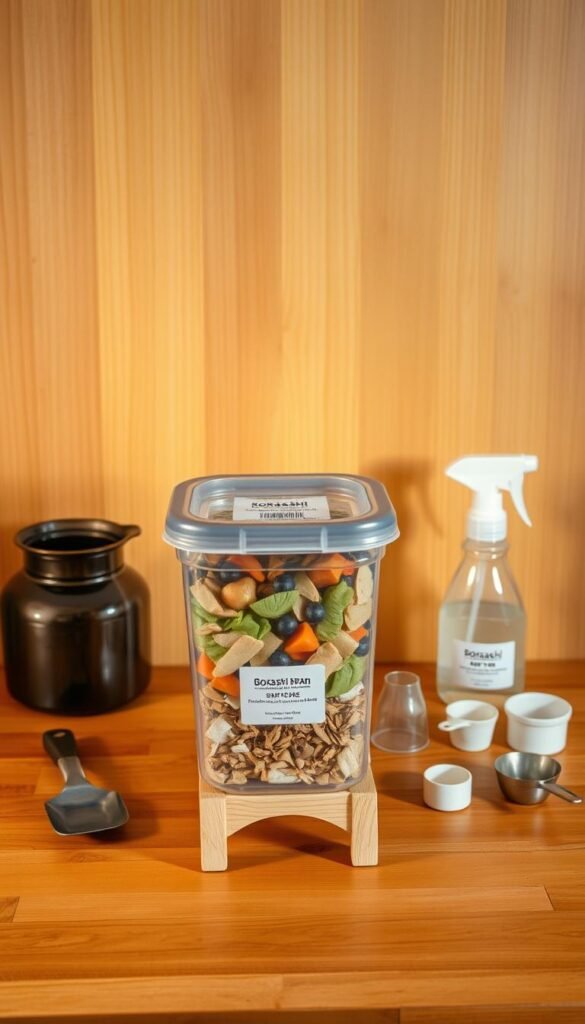
Ever wondered how to compost dairy or meat without odors? Bokashi fermentation offers a clever workaround. Unlike traditional methods, this anaerobic process pickles scraps using beneficial microbes, handling everything from chicken bones to cheese rinds.
What is Bokashi Composting?
This technique relies on effective microorganisms (EM) in bokashi bran to break down waste. You’ll layer food scraps with the bran in an airtight container, creating an oxygen-free environment. The microbes ferment organic matter quickly—no rotting smells.
Setting Up Your Bokashi Bin
Start with two 5‑gallon buckets. Drill drainage holes in the bottom of one for collecting liquid (called “bokashi tea”). Here’s how to assemble it:
- Place the drilled bucket inside the solid one
- Add food scraps in 2-inch layers
- Sprinkle bokashi bran generously over each layer
- Press down to remove air pockets
- Seal tightly between additions
Drain the nutrient-rich tea every few days and dilute it 100:1 for plant food. After two weeks of fermentation, bury the pre-compost in garden soil or add it to outdoor bins. The process enriches soil faster than standard decomposition.
Pro tip: Chop large scraps to speed up fermentation. This method thrives in closets or under sinks, making it ideal for urban homes. Ready to use bokashi for your toughest food waste?
How to Set Up Your Worm Bin: A Step-by-Step Guide
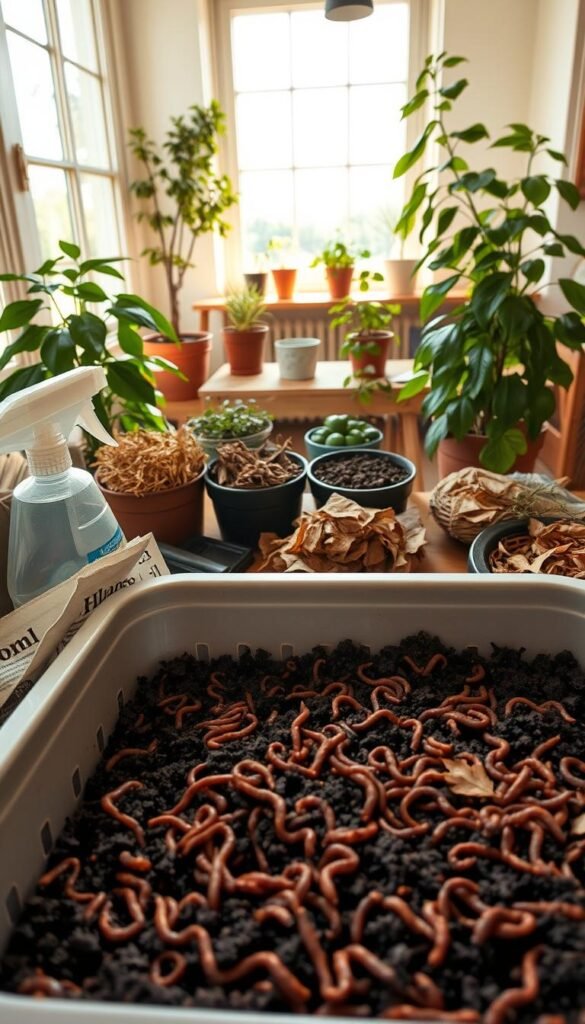
Ready to turn kitchen scraps into garden gold? Building your own worm bin is simpler than you think. With a couple of plastic buckets and everyday materials, you’ll create a thriving ecosystem right at home.
DIY Tips for Assembling Your Worm Bin
Start with two 5-gallon buckets. Drill 10-15 small holes in the bottom of one for drainage. Stack it inside the solid bucket—this catches excess water. Add shredded newspaper or cardboard as bedding, moistened like a wrung-out sponge.
Introduce red wigglers to their new bin with a handful of soil. Begin feeding small amounts of chopped scraps under a top layer of bedding. Rotate feeding zones weekly so worms migrate upward, leaving finished castings below.
Maintaining Optimal Moisture Levels
Use a spray bottle to mist the bedding when it feels dry. If condensation forms on the lid, add dry newspaper strips to absorb extra moisture. Check weekly by squeezing a handful—drops should barely form.
Limit disturbances to keep worms comfortable. Only lift the top layer when adding food. Toss in bread crumbs occasionally for dietary variety, but avoid overfeeding. In time, you’ll master the rhythm of layer rotation and moisture checks.
Initiating Your Bokashi Composting Process
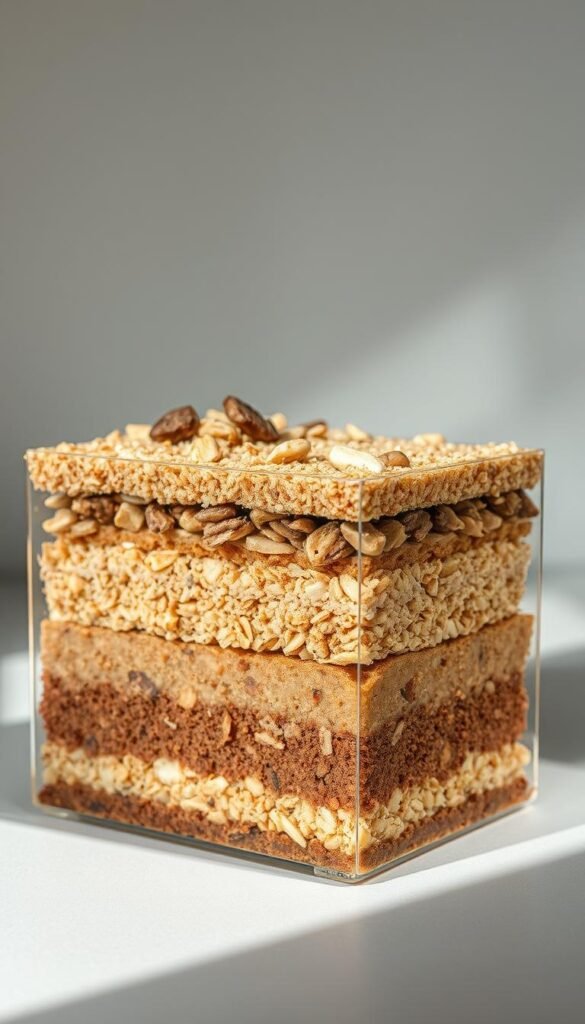
Got a countertop full of food scraps? Bokashi fermentation turns them into plant fuel in just two weeks. This method thrives on layering precision and airtight conditions to pickle waste without odors.
Layering Like a Pro
Start with a clean bokashi bin. Chop scraps into 2-inch pieces for faster breakdown. Alternate food layers with handfuls of bokashi bran, pressing firmly after each addition. Use a plate to compress materials and eliminate air pockets.
| Layer Component | Purpose | Frequency |
|---|---|---|
| Food Scraps | Base material | Daily additions |
| Bokashi Bran | Microbe activation | After every scrap layer |
| Compression | Oxygen removal | With each new layer |
Harvesting Liquid Gold
Check the spigot every 3 days. Drain bokashi tea into a container before it overflows. Dilute 1 teaspoon per gallon of water for houseplants—it’s packed with nutrients.
Seal the bin tightly between uses. After two weeks, the fermented scraps will smell tangy, not rotten. You’ll need to bury them in soil or add to outdoor compost to finish breaking down.
Pro tip: Mark your calendar when starting a new batch. Consistent timing ensures you put bokashi scraps to work efficiently. Miss a layer? Add extra bran to keep fermentation on track.
Choosing the Right Composting System for Your Home
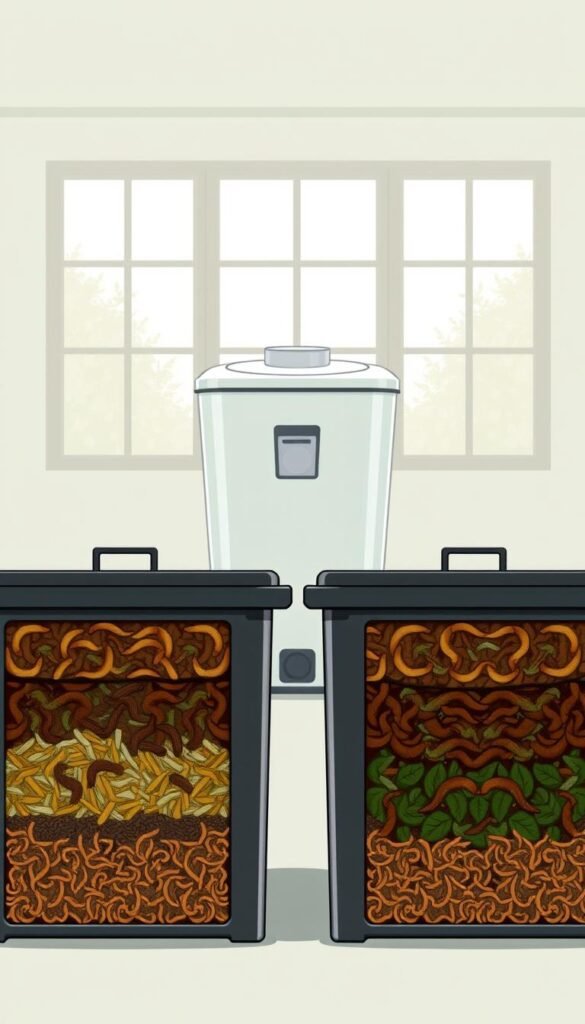
Stuck between two composting methods? Your decision hinges on three factors: available space, types of food waste, and how hands-on you want to be. Both systems shrink landfill contributions but work differently to nourish your garden.
Assessing Space and Waste Compatibility
Worm bins thrive in spots with steady airflow—like under sinks or in garages. They require 12-18 inches of vertical room for stacking trays. These setups excel with fruit peels and coffee grounds but can’t handle meat or oily leftovers.
Bokashi buckets fit anywhere airtight, even cramped cabinets. Their fermentation process digests dairy, bones, and citrus without odors. You’ll need a second location (like outdoor soil) to bury pre-compost after the initial 2-week fermentation.
Benefits of Each Method
Vermicomposting delivers ready-to-use castings in 2-3 months—perfect for enriching houseplants. The worm workforce requires weekly checks but rewards you with odor-free operation.
Bokashi shines when speed matters. Fermented scraps break down fully in soil within 4 weeks. You’ll drain nutrient-rich “tea” weekly for instant plant food. Just remember: you’ll need bran refills and a burial spot for fermented waste.
| Factor | Worm Bin | Bokashi |
|---|---|---|
| Space Needed | Vertical airflow | Airtight corner |
| Waste Types | Plant-based only | All food scraps |
| Maintenance | Bedding changes | Bran replenishment |
Choose based on your kitchen waste profile and patience level. Apartment dwellers love bokashi’s meat-friendly design, while gardeners prize worm castings’ soil-boosting power. Either way, you’re turning scraps into garden gold.
Optimizing Maintenance and Care in Indoor Composting
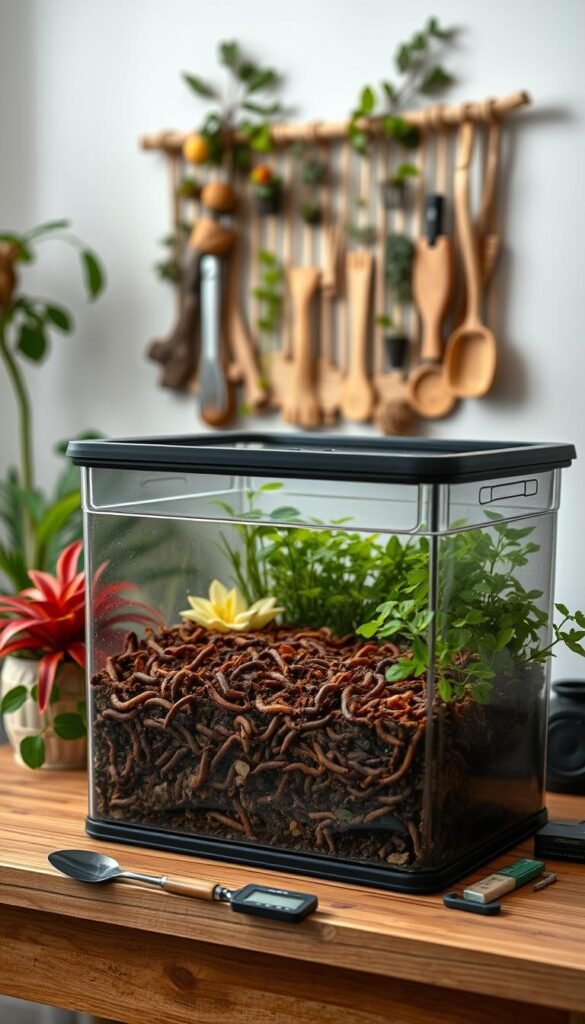
Your indoor compost system thrives with consistent attention—like a living appliance needing regular tune-ups. Simple daily checks and weekly tweaks keep your setup odor-free and productive. Think of it as nurturing a mini ecosystem that rewards diligence with nutrient-packed results.
Daily and Weekly Routines Made Simple
Start each morning with a quick moisture check. Squeeze a handful of bedding—it should feel like a damp sponge. Add dry shredded paper if soggy, or mist with water if crumbling. For bokashi users, drain the liquid every 3 days to prevent overflow.
Weekly tasks take just 10 minutes:
- Fluff bedding in worm bins to improve air circulation
- Rotate food placement zones to prevent uneven decomposition
- Inspect for dry pockets or matted layers needing separation
| Task | Frequency | Action |
|---|---|---|
| Moisture Check | Daily | Adjust with bedding/water |
| Liquid Drainage | Every 3 days | Collect bokashi tea |
| Bedding Aeration | Weekly | Mix layers gently |
Balancing air and moisture prevents 80% of common issues. For aerobic systems like worm bins, occasional stirring introduces oxygen. Anaerobic bokashi needs airtight seals—press layers firmly to eliminate trapped air.
Consistent care means faster compost production. You’ll notice richer soil amendments for your plants within weeks. Set phone reminders until these habits become second nature. Your future garden—and planet—will thank you.
Troubleshooting Common Composting Challenges
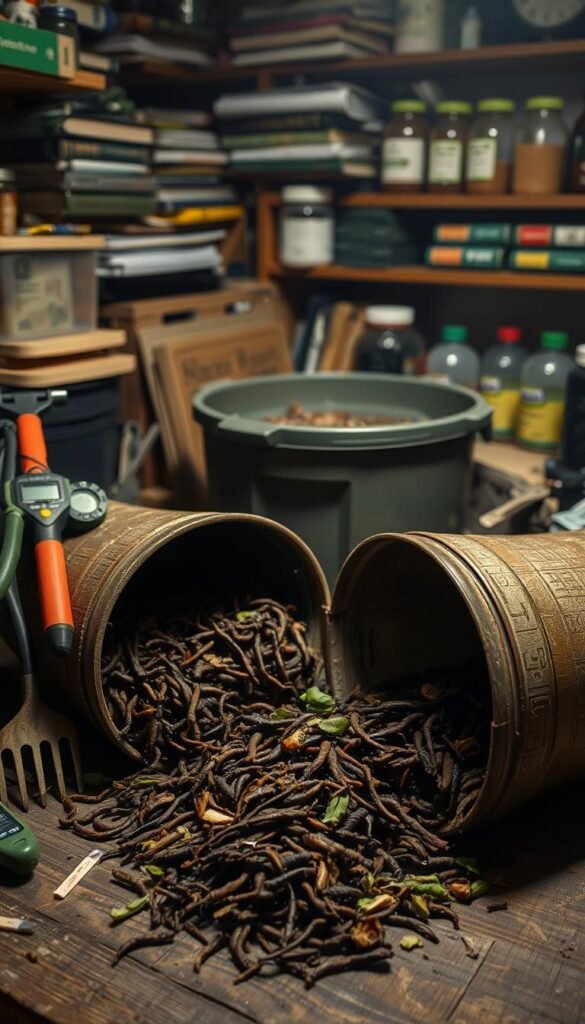
Even the best systems hit occasional snags. Don’t panic—most issues have quick fixes once you know what to look for. Let’s tackle two frequent headaches and get your setup back on track.
When Your Worm Bin Smells Funky
A healthy bin should have an earthy aroma. If it starts to smell like rotten eggs or ammonia, check moisture first. Overwatered bedding drowns worms and creates anaerobic pockets. Mix in shredded cardboard to absorb excess liquid.
Food overload also causes odors. Bury scraps under bedding and reduce portion sizes. If citrus or onion peels snuck in, remove them—they’re too acidic. Still stinky? Add crushed eggshells to neutralize pH.
Reviving Stalled Bokashi Fermentation
Proper bokashi should smell like pickles, not garbage. A foul odor means air infiltrated the bucket full of scraps. Re-press layers to eliminate gaps and sprinkle extra bran to restart microbial activity.
White mold is normal, but black mold signals trouble. Toss contaminated batches and sanitize your container. If fermentation drags past two months, check temperatures—microbes slow below 60°F. Move the bin somewhere warmer.
| Issue | Quick Fix | Prevention Tip |
|---|---|---|
| Soggy Worm Bin | Add dry newspaper | Drain liquid weekly |
| Bokashi Not Breaking Down | Add more bran | Chop scraps smaller |
Pro tip: Mark calendar dates when filling bins. This helps track progress and catch delays early. With these adjustments, you’ll use bokashi and vermicomposting like a pro—no PhD required.
Small Space Composting: Worm Bins and Bokashi Explained
Your kitchen scraps hold hidden potential—transform them into garden treasures effortlessly. Whether you choose worm bins or bokashi fermentation, both systems shrink waste while boosting soil vitality. Let’s revisit how these methods turn everyday leftovers into eco-friendly victories.
Vermicomposting thrives with red wigglers munching through fruit peels and coffee grounds. Stacked trays let worms migrate upward, leaving nutrient-rich castings below. Keep bedding damp and avoid acidic scraps for a thriving ecosystem under your sink.
Bokashi handles tougher materials like meat and dairy through microbial fermentation. Layer scraps with bran in an airtight bin, then drain “tea” weekly for instant plant food. After two weeks, bury the fermented mix to complete decomposition.
| Feature | Worm Bin | Bokashi |
|---|---|---|
| Best For | Plant-based scraps | All food types |
| Setup Time | 2-3 months | 2 weeks |
| Space Needed | Vertical airflow | Airtight corner |
Both methods reduce landfill contributions and enrich soil without demanding much room. Rotate food layers in your bin or press scraps tightly in bokashi—consistency matters more than complexity.
Ready to start? Review the setup guides and pick the system that matches your kitchen habits. Your plants—and the planet—will reap the rewards.
Wrapping Up Your Indoor Composting Journey
Imagine turning everyday kitchen leftovers into a resource that enriches your plants and reduces waste. Whether you prefer the steady work of worm-powered systems or the speedy fermentation of bokashi, both methods shrink your trash while feeding your garden. You’ve learned how to convert banana peels and coffee grounds into nutrient-packed soil enhancers—no backyard required.
While worm bins excel with plant-based scraps, bokashi handles meat and dairy effortlessly. One thrives on airflow, the other on airtight conditions. Yet both share a common goal: transforming food scraps into “black gold” for your plants.
Don’t fear tweaking your process. Adjust feeding schedules, experiment with moisture levels, or try mixing compost into garden soil differently. Even a couple of small changes over time can boost results. Remember to check airflow in worm habitats and drain bokashi tea weekly.
Your efforts pay off in healthier plants and richer soil. Share your successes—and stumbles—with fellow eco-enthusiasts. Every coffee ground buried or citrus peel fermented brings us closer to greener homes and communities.
Ready to dig deeper? Start today, and watch your kitchen waste become tomorrow’s garden triumph.

